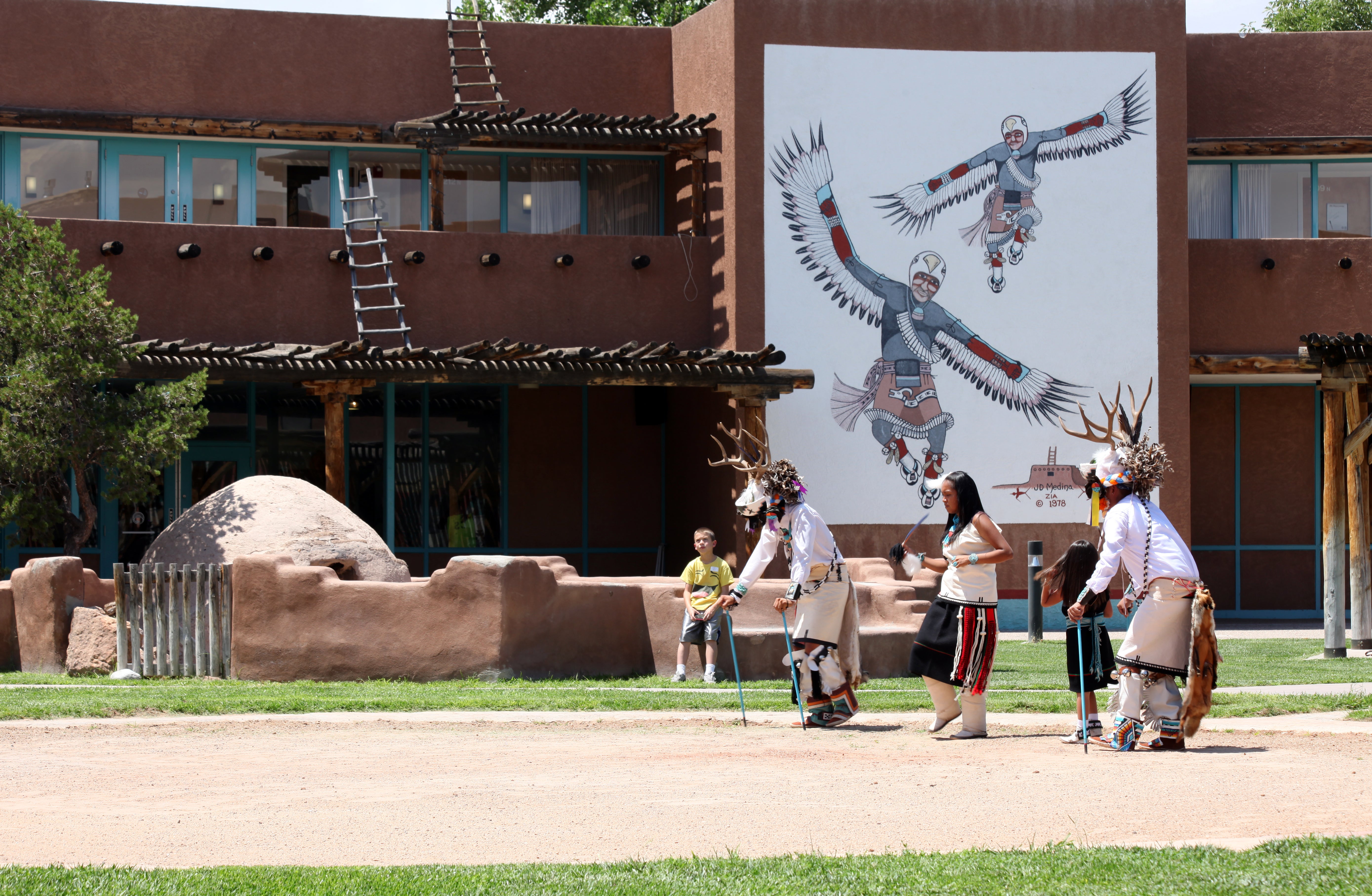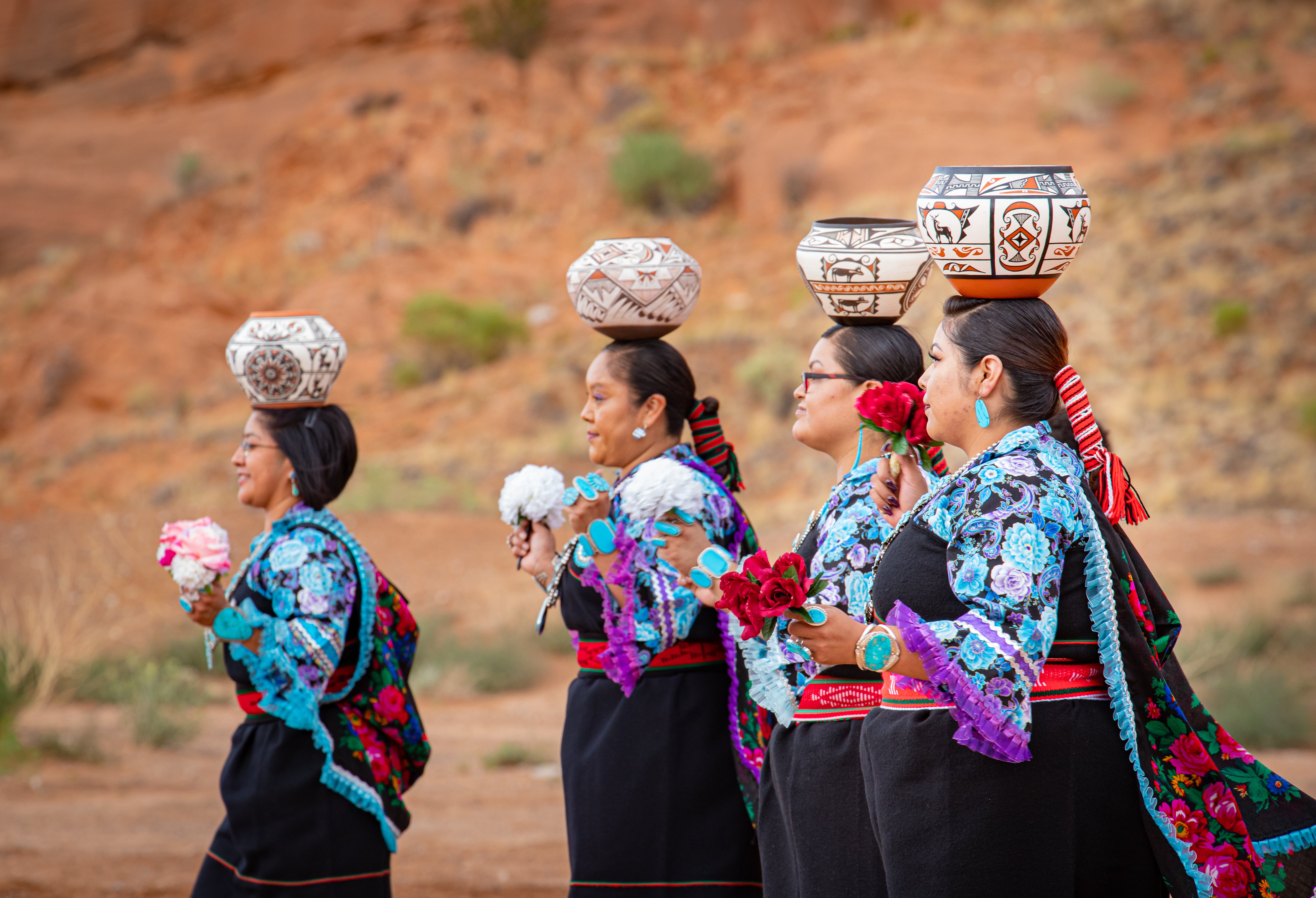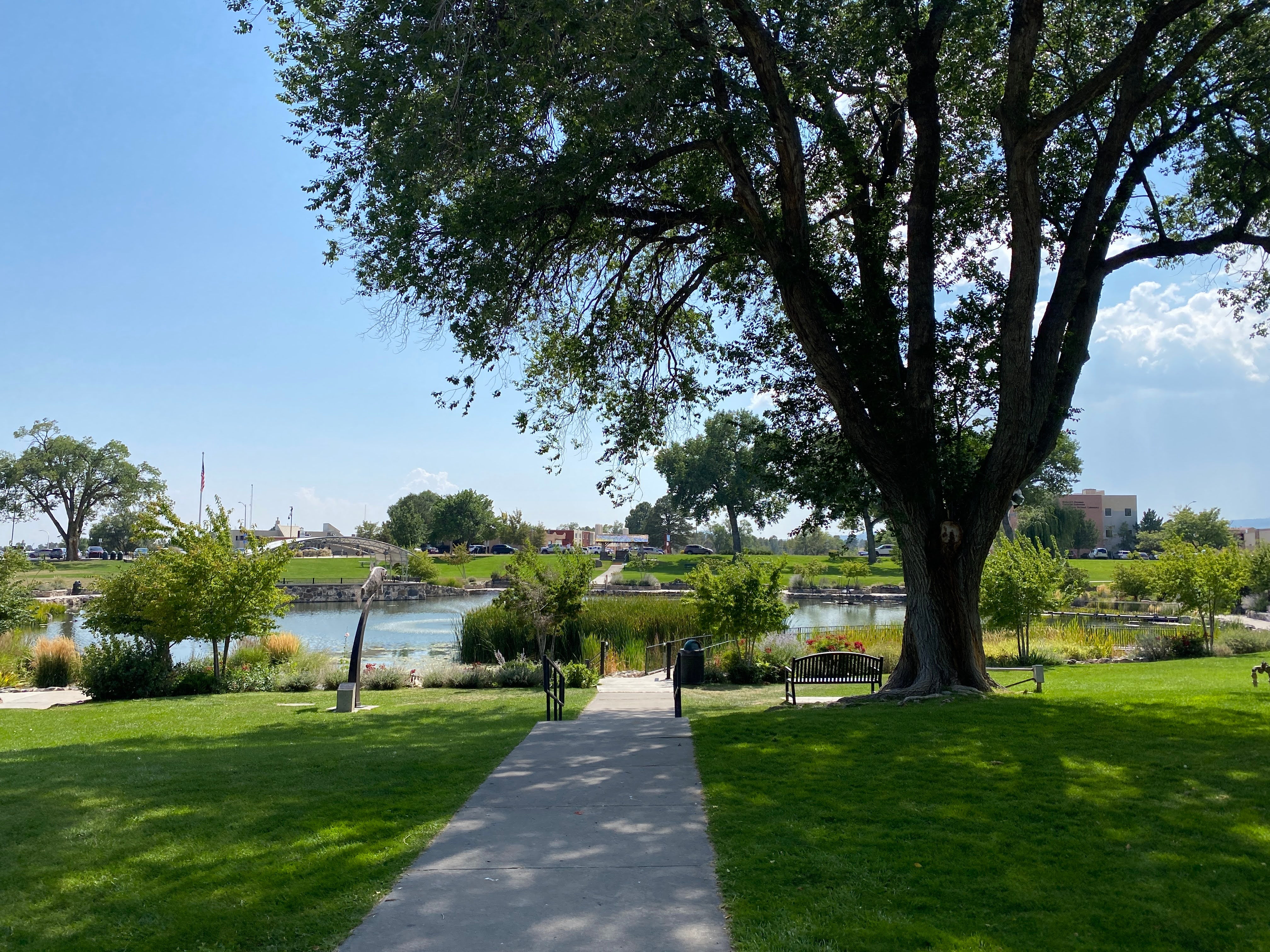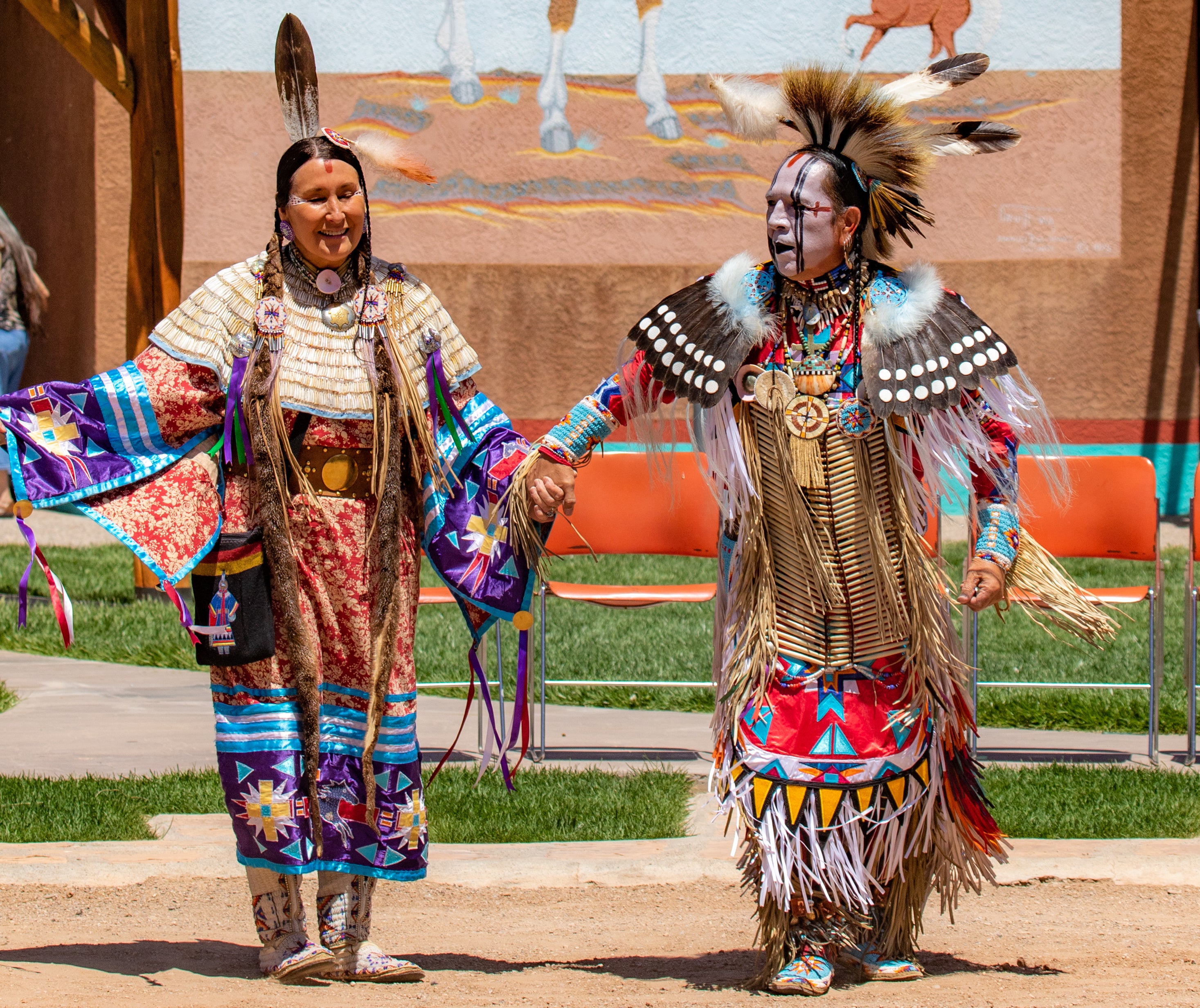How I decolonised my trip to New Mexico
There’s more than one way to be a responsible, thoughtful traveller, as Megan Eaves discovers on a visit back to her home state

The sun daubs the sky hot pink and orange over a row of small, undulating mountains, a few puffy white clouds reflecting the palette like a perfect desert painting. Between me and the hills are wide-open pastures of grama grass and chamisa bushes tinted green from recent rain, spindly-armed cholla cactus and fat juniper trees, their 400-year-old branches turning inky in the fading southwest light. Everything is soft, and the scent of moisture clinging to clay dirt hits my nose – a deep, earthy fragrance. Sunsets hit different in my home US state, New Mexico.
These are Los Cerrillos, the “Little Hills”, and though I’ve been a Londoner for more than a decade, I spent my childhood here in a small adobe (mud-brick) house on a tract of rural land 20 miles south of the state capital, Santa Fe. Like many, I have endured the pandemic alone in a tiny flat. So when the time came to burst out of lockdown, there was no question: I was heading straight to America for hugs, family meals, belly laughs and margaritas on the patio.
But, as a travel journalist, I’ve become hyper-cognisant of travel’s negative effects – and, since flying was inevitable, I wanted to find other ways to give my journey home a positive impact.

Ethical travel beyond flight-free
Apart from carbon-cutting, the biggest impacts of travel, both positive and negative, are how we show up in a destination. There are no hard-and-fast rules: ethical travel is about connecting profoundly with the places and people we visit; about keeping our minds open, listening and letting travel challenge us, make us uncomfortable and change us.
A good start is asking ourselves questions like, “Who does this benefit?”; “What am I learning?”; “Where is my money going?”; “What positive impacts does this have?”; “What are the negative environmental and cultural costs to my trip?”; and “What is the colonial history of this place?”
For this trip, I created a few goals and guidelines for myself: self-education, particularly deeper learning about Native American cultures indigenous to my state, its colonial history, and its role in developing the atomic bomb. I planned to intentionally support only local and mainly Native-owned businesses rather than chains, to visit under-served communities and small towns, to stay with family and friends or in locally owned accommodation, to eat mainly vegetarian and to share my learning with others.

Homeland of the Pueblo peoples
New Mexico was one of the last states to join the union, added to the United States in January 1912 – 125 years after Delaware became the first state. This is a great irony considering that the lands of New Mexico were first settled 10,000 years ago by tribes who constructed great cities and sophisticated irrigation systems. Spanish colonisers, led by Francisco Vasquez de Coronado, marched through in 1541 in search of the fabled “Seven Cities of Gold”. Instead, they found large Native American cities (which they promptly tried to take over and convert) and called these tribes pueblos, the Spanish word for “town”. Of the 23 indigenous tribes in New Mexico, 19 are Pueblos.
On my first morning at my sister’s house, we take a short hike around the land where we grew up, following small gullies washed out during the summer monsoon season down to the arroyo (dry stream bed) below the house. Along the way, I spot a piece of pottery and stop to pick it up – sherds and arrowheads are all over the land here.
Our Pueblo people started many of the iconic, southwestern art forms that people love about New Mexico – architecture, fashion, art, food and more
Long before my grandparents arrived and bought the land in the early 1950s, this was the Ya’atze/Kunyanonwikeji people’s home from at least the 1200s. A huge city comprising 22 three-storey blocks stood about two miles from my childhood home. The people were ceramicists and artisans who used turquoise from the Cerrillos Hills to make the iconic jewellery that has been appropriated as “southwest style” today.
To learn more about the Pueblo peoples’ past and present, I visit the Indian Pueblo Cultural Centre (IPCC) in Albuquerque. Run by a sovereign government formed by the 19 tribal councils, its exhibits show the Puebloan arts and traditional ways of life, such as the adobe building construction that has become New Mexico’s architectural drawcard.
This is also the only place in North America that hosts indigenous dances every weekend, year-round. On my visit, the Pueblo Dance Group, formed by performers from Laguna, Acoma, Zuni and Hopi Pueblos, takes to the centre courtyard. Women wear white sheath dresses with beaded hems and the men don buffalo hides, stepping in time with chanting drummers.

I ask Wende Schwingendorf, the centre’s PR manager, why it’s so important for visitors to New Mexico to learn about Pueblo communities.
“Our Pueblo people started many of the iconic, southwestern art forms that people love about New Mexico – architecture, fashion, art, food and more,” she says, adding that the IPCC is a gateway to the 19 Pueblos. “You’ll be supporting Pueblo people with positive economic development and employment opportunities.”
She also recommends having Pueblo food at the IPCC’s Indian Pueblo Kitchen. The menu features feast-day stew, prime rib fry bread dip and blue corn enchiladas, but I opt for the Tewa Taco: minced beef, beans, New Mexican chile (not “chilli”, the spelling is enshrined in state law), cheese and salad atop fresh fry bread.
In non-pandemic times, you can visit many of the Pueblos, including on feast days when dances are held – and you might be invited into a community member’s home for traditional food (never enter without being invited). However, Native American communities have been disproportionately affected by Covid-19, so many are currently closed. Zuni Pueblo is open, though, and runs weekday tours with experienced Zuni archaeologists.
Shonto Begay poignantly portrays his life on the Navajo reservation – and the trauma of being forcibly separated from his family to attend boarding schools
One of the ways visitors can be respectful is by educating themselves on the etiquette, policies and procedures of each tribe before a visit, according to Melvin Juanico, operations manager at Sky City Cultural Centre at Acoma Pueblo – one of the oldest inhabited communities in North America. For example, photography is prohibited on many Native lands. He adds that visitors should “be courteous to our tribal members and treat them with respect when greeting and talking with them”.
With such a rich Indigenous history, it’s no wonder that New Mexico is one of the best places in the world to immerse yourself in Native American art. The IAIA Museum of Contemporary Native Arts, Museum of Indian Arts and Culture and Wheelright Museum of the American Indian all offer comprehensive exhibits on Native American arts past and present.
On my visit to the Wheelwright Museum, an exhibition of paintings by Diné (Navajo) artist Shonto Begay poignantly portrays his life on the Navajo reservation – and the trauma of being forcibly separated from his family to attend boarding schools designed to assimilate indigenous children into western society.
An atomic history
On my last few days in New Mexico, my best friend joins me for a road trip north. We follow deserted back roads into the Jemez Mountains, where table-flat mesas give way to high-altitude evergreen forests in which the Walatowa people (Jemez Pueblo) have lived for centuries.

Their traditional fieldhouse museum and Red Rocks Canyon hiking trail are both Covid-closed, so we press on higher into the mountains and pull off at a roadside car park. A short hike into a coniferous woodland brings us to Spence Hot Springs – warm pools fed by a mineral spring overlooking a wide, evergreen valley bounded by the bluest of skies. The Pueblo people used these springs for healing and spiritual activities until white settlers started arriving in stagecoaches to bathe.
We stop off for a green chile cheeseburger at Los Ojos, an 1800s mercantile store turned bar-and-grill. Inside, it’s like a real old-west saloon: there are creaky wood floors, saddles and taxidermied rattlesnakes on the walls, along with a wagon-wheel chandelier.
Finally, we reach Los Alamos. Nicknamed “the town that never was”, this was the base of the top-secret Manhattan Project, where the first atomic bomb was developed in the 1940s. The Los Alamos History Museum is located in the complex that formed the project’s base.
It traces the history of the area, starting from the Ancestral Puebloan peoples through to the Manhattan Project, explaining that Los Alamos was chosen primarily because of its remote location. One room displays video interviews with Japanese survivors and former US soldiers involved in the bombings of Hiroshima and Nagasaki. Visitors are invited to write reflections in a guestbook filled with emotional outpourings. Another gallery displays a pair of ginkgo plants with a sign: “These seedlings, planted in June 2017, grew from seeds that came from trees that survived the atomic bombing of Hiroshima. They are a gift from Green Legacy Hiroshima and the Hiroshima Botanical Garden.”

On our final morning, we rise early and drive over a red mesa dotted with shrubby pinon trees and past mysterious-looking lab buildings, into Frijoles Canyon, where hunter-gatherers lived 10,000 years ago. The Ancestral Puebloan people built a great city here starting in 1150 CE, now preserved as Bandelier National Monument. The Ancestral Puebloans were previously called the “Anasazi”, a name now considered offensive because it means “ancient enemy” and was propagated by white archaeologists.
A 1.4-mile trail leads through the main settlement, where wooden ladders and vertiginous stone steps let you peer into some of the main dwellings. A series of thousand-year-old petroglyphs decorate the smooth, tan sandstone cliff.
On my final day in Albuquerque, I stop into Bow and Arrow Brewing Co., founded and owned by two Native American women, Shyla Sheppard and Missy Begay. Settling down with a deliciously hoppy Native Land IPA, I open a secondhand book procured a few days earlier – Spider Woman's Granddaughters. Full of traditional tales and contemporary writing by Native American women, I can scarcely think of a better souvenir for my trip.
Travel essentials
Getting there
Trying to fly less?
Those who aren’t time-short can take the Eurostar to Rotterdam, hop on a cargo ship to Houston, Texas and then catch an Amtrak train or Greyhound bus to Albuquerque.
Fine with flying?
There are no non-stop flights, but you can fly from Heathrow to Albuquerque via Denver on United or via Dallas on American Airlines.
Staying there
Hotel Santa Fe is a Picuris Pueblo-owned boutique hotel with Green Concierge certification, a lush spa and a restaurant serving upscale Puebloan cuisine.
More information
The New Mexico Rail Runner train serves Santa Fe, Albuquerque and central New Mexico. Visit in April to attend the Gathering of Nations, the largest powwow in North America.
The author acknowledges that she grew up on the ancestral lands of Puebloan people. Half of the proceeds from this article were donated to the Indian Pueblo Cultural Centre to support its mission of preserving and perpetuating Pueblo culture.
Join our commenting forum
Join thought-provoking conversations, follow other Independent readers and see their replies
Comments